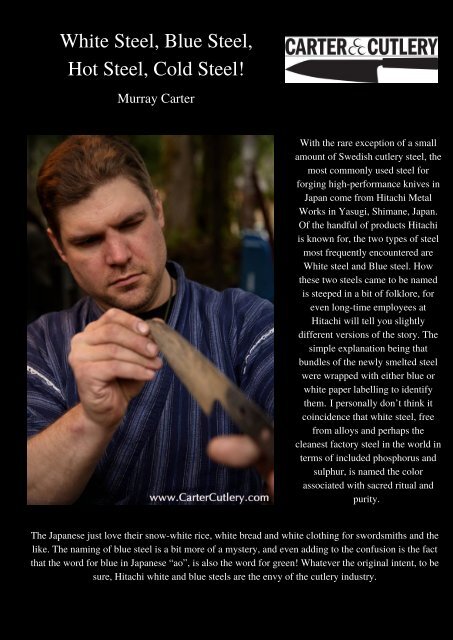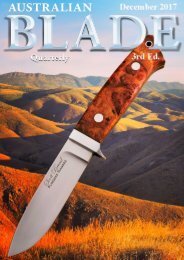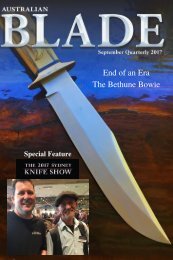Australian blade 4th edition
Create successful ePaper yourself
Turn your PDF publications into a flip-book with our unique Google optimized e-Paper software.
the rare exception of a small<br />
With<br />
of Swedish cutlery steel, the<br />
amount<br />
commonly used steel for<br />
most<br />
high-performance knives in<br />
forging<br />
come from Hitachi Metal<br />
Japan<br />
in Yasugi, Shimane, Japan.<br />
Works<br />
the handful of products Hitachi<br />
Of<br />
known for, the two types of steel<br />
is<br />
frequently encountered are<br />
most<br />
steel and Blue steel. How<br />
White<br />
two steels came to be named<br />
these<br />
steeped in a bit of folklore, for<br />
is<br />
long-time employees at<br />
even<br />
will tell you slightly<br />
Hitachi<br />
versions of the story. The<br />
different<br />
explanation being that<br />
simple<br />
of the newly smelted steel<br />
bundles<br />
wrapped with either blue or<br />
were<br />
paper labelling to identify<br />
white<br />
I personally don’t think it<br />
them.<br />
that white steel, free<br />
coincidence<br />
alloys and perhaps the<br />
from<br />
factory steel in the world in<br />
cleanest<br />
of included phosphorus and<br />
terms<br />
is named the color<br />
sulphur,<br />
with sacred ritual and<br />
associated<br />
Japanese just love their snow-white rice, white bread and white clothing for swordsmiths and the<br />
The<br />
The naming of blue steel is a bit more of a mystery, and even adding to the confusion is the fact<br />
like.<br />
the word for blue in Japanese “ao”, is also the word for green! Whatever the original intent, to be<br />
that<br />
Hitachi white and blue steels are the envy of the cutlery industry.<br />
sure,<br />
White Steel, Blue Steel,<br />
Hot Steel, Cold Steel!<br />
Murray Carter<br />
purity.





